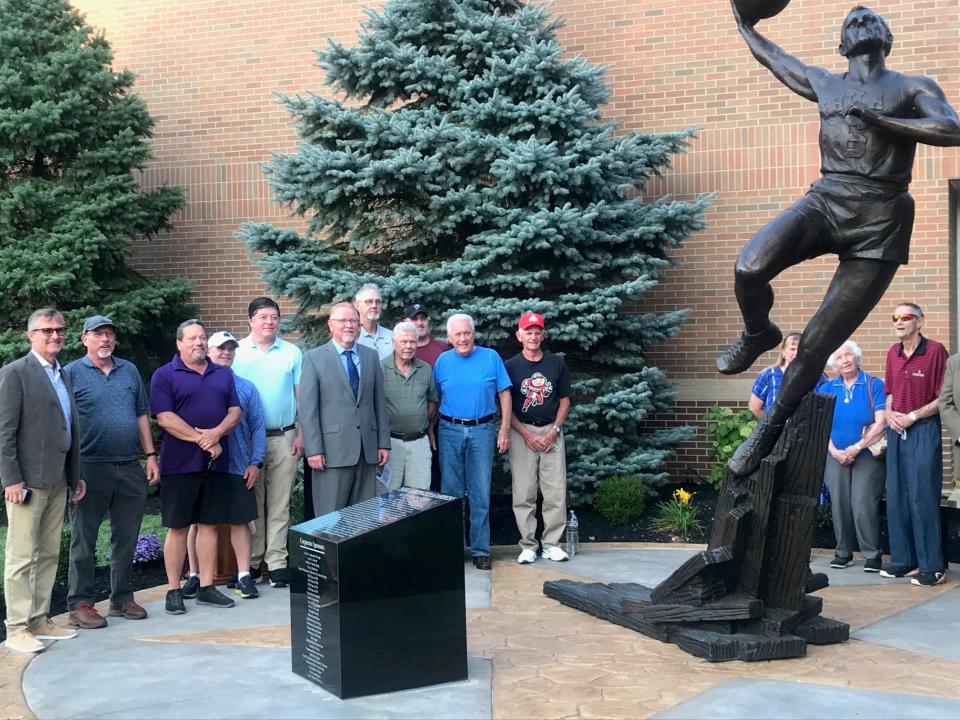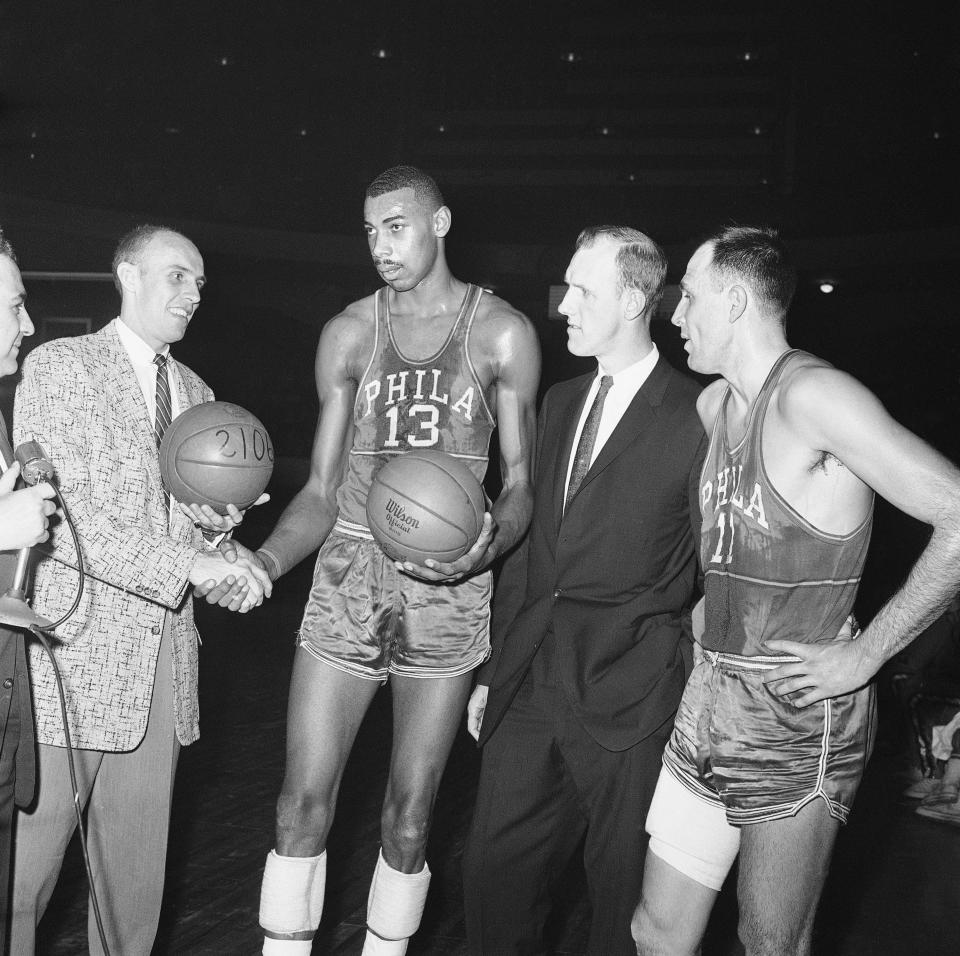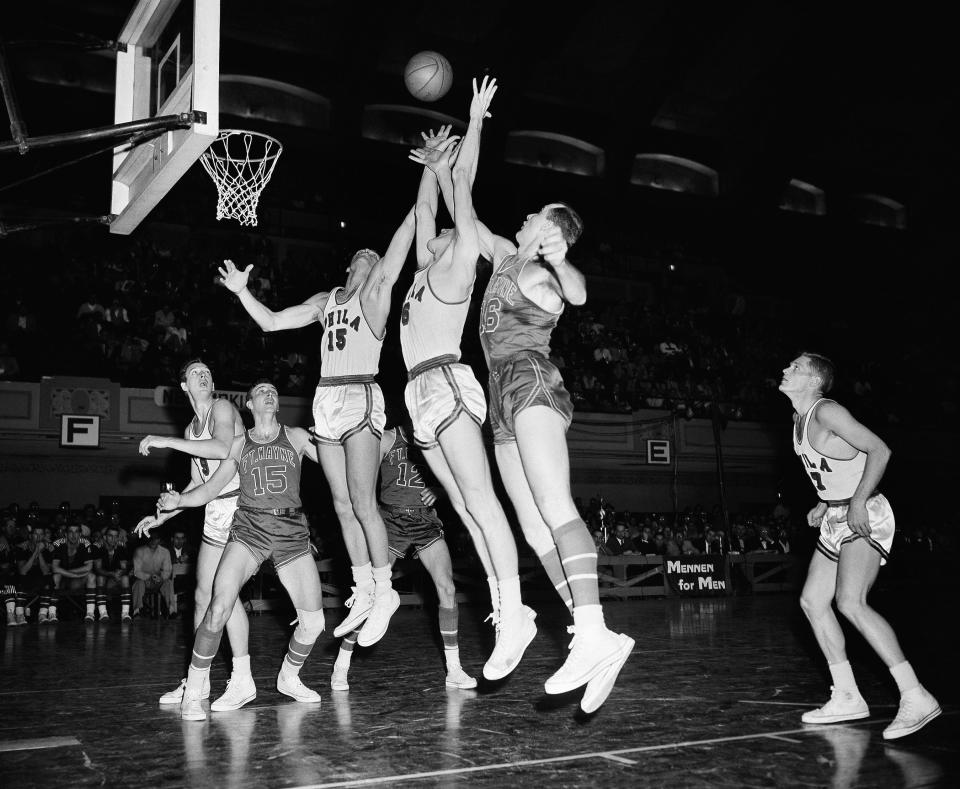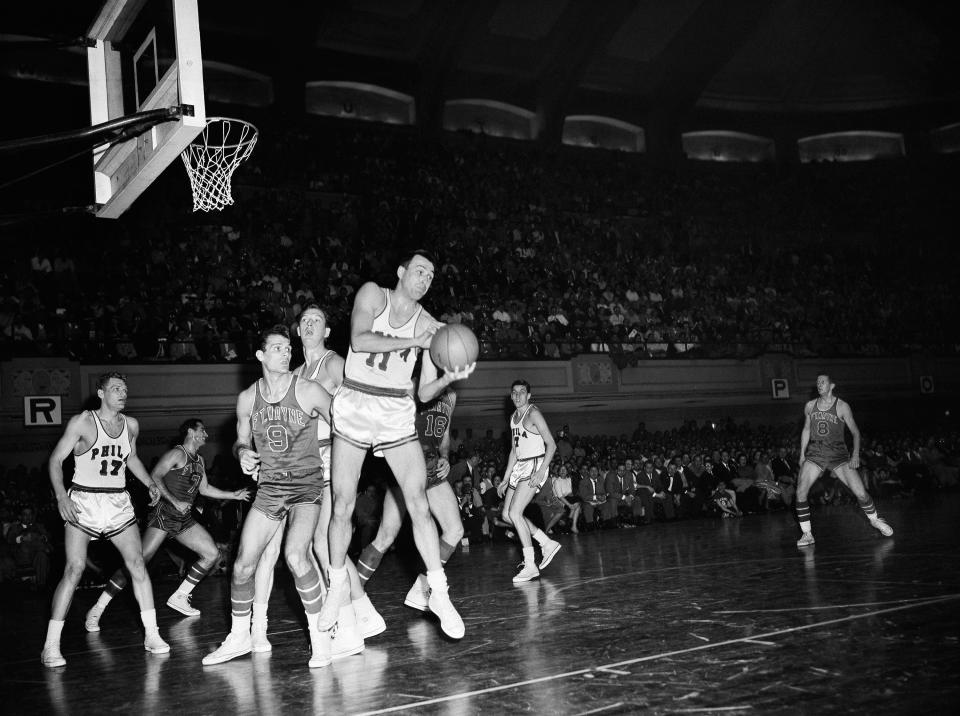Neil Johnston could be the greatest basketball player you've never heard of | Michael Arace
- Oops!Something went wrong.Please try again later.
- Oops!Something went wrong.Please try again later.
- Oops!Something went wrong.Please try again later.
- Oops!Something went wrong.Please try again later.
- Oops!Something went wrong.Please try again later.
- Oops!Something went wrong.Please try again later.
- Oops!Something went wrong.Please try again later.
- Oops!Something went wrong.Please try again later.
Ever heard of Neil Johnston?
He was only one of the greatest basketball players of his generation.
He was from Chillicothe.
Ring a bell?
If you’re a basketball junkie, the Naismith Memorial Basketball Hall of Fame website is not merely a rabbit hole, it is a warren of wonder. You can get lost in there, as I did one day last month. I searched for “Ohio” among Hall of Famers. Ten mugshots appeared.

The 10 mugshots are players, coaches and/or administrators, all of whom have a connection to Ohio State. The most instantly recognizable: Jerry Lucas, one of the greatest college players of all time and a member of every NBA anniversary team; John Havlicek, who went to three consecutive NCAA championship games with Lucas and was an even better pro; and Katie Smith, who is one of the most highly decorated female athletes in history, in any sport.
Scroll over the mugshots and the names appear. There are old timers such as Lynn St. John, who has an arena named for him. There are icons who only passed through Columbus, such as Tara VanDerveer, who is most associated with Stanford as the winningest women’s coach of all time. (Geno’s sneaking up on her, though.) There is Arnie “Stilts” Risen, who led Ohio State to the Final Four in 1944 and ‘46, and who went on to win NBA rings with the Rochester Royals and Boston Celtics.
What you don’t expect is to scroll over a mugshot, look at a name and be utterly gob-smacked.
Neil Johnston?
Who?
“He’s probably the most overlooked superstar in the history of basketball,” said Bruce Caplinger, a Chillicothe sports historian, memorabilia collector and keeper of Johnston’s legacy. More on Caplinger in a minute.
The Hall of Fame bio goes like this:
With a devastating sweeping hook shot from the pivot, Neil Johnston became one of the early NBA's most prolific scorers. The 6-foot-8-inch former minor league baseball star played eight NBA seasons with the Philadelphia Warriors. During the 1953-54 season, "Gabby" enjoyed five of the league's top six individual game highs, and led the NBA with a 50-point effort against Syracuse. A multidimensional player, Johnston used his athletic talent to lead the NBA in scoring (1953, 1954, 1955), rebounding (1955), and field goal percentage (1953, 1956, 1957). For five consecutive seasons starting in 1953, Johnston averaged better than 20 points per game despite playing during an era of legendary centers. After a career-ending knee injury, Johnston became coach of the Philadelphia Warriors and the Pittsburgh Rens of the American Basketball League as well as the Wilmington Blue Bombers of the Eastern Basketball League.
To say he was one of the greatest basketball players of his generation might even be coming up short. Modern metrics proclaim Johnston as a monster for the ages.
John Hollinger is a former NBA executive who is known for as a pioneer in basketball analytics. He is most famous for his Player Efficiency Rating (PER), which uses a formula that adds positive stats and subtracts negative stats.
Michael Jordan is the NBA’s all-time PER leader and No. 2 is LeBron James. At No. 10 on the list – just behind Kevin Durant and just ahead of Giannis Antetokounmpo – is Neil Johnston.
Another advanced metric that attempts to measure an individual’s contribution to a team’s success is Win Shares.
Michael Jordan is the all-time leader in Win Shares per 48 minutes with .2505. David Robinson is No. 2, Wilt Chamberlain is No. 3 and – just ahead of Nicola Jokic, Chris Paul, Kareem Abdul-Jabar and LeBron – is Neil Johnston at No. 4.
He’s on some crazy lists, Johnston is.
Like, on Dec. 4, 1954, playing against the Syracuse Nationals, Johnston set a then-record with 39 rebounds in a game. Here’s the list of players who subsequently pulled down 40-plus boards in a single NBA game: Wilt Chamberlain (16 times), Bill Russell (11 times), Nate Thurmond and Jerry Lucas. And that’s it.
Like, here’s the list of NBA players who led the league in scoring three years in a row: Jordan (twice), George Mikan, Wilt, Durant, James Harden, Bob McAdoo and Johnston. And that’s it.
Like, here’s the list of players who led the league in points, rebounds and field-goal percentage: Wilt, Kareem Abdul-Jabbar and Johnston. And that’s it.
Hoops aficionados have probably heard of George Mikan, who led the dynastic Minneapolis Lakers to five NBA titles in the late 1940s and early 1950s. Basketball Joneses have definitely heard of Russell, the foundation of a Celtics dynasty that racked up 11 titles in 13 seasons from 1957-1969 (when Chamberlain was in his prime.)
Between these dynasties there was Johnston, who was less famous than his sharp-shooting teammate, Paul Arizin, and certainly less well-known than Bob Pettit – who supplanted Johnston as the scoring champion the year Johnston’s Warriors won the NBA title in 1956.
Yet, Johnston was the most unstoppable force in the league throughout most of his career. He was the prime big man of the era that bridged from Mikan to Russell/Chamberlain.
This is his thumbnail bio from the 1957 All-Star Game program:
Couldn’t make Ohio State team as a soph., failed as a big league aspirant with a sore arm, turned to basketball where he won scoring titles in 1953, 1954 and 1955. Named All-NBA in 1953, 1954, 1955, 1956, also East-West (All-Star) game in 1953, 1954, 1955, 1956, played most time of anyone in 1953 with 3,166 minutes, 3,296 in 1954. Led NBA in rebounds in 1955 with 1,085. Has one of the finest hook shots in the league.
Let’s take a quick look at the 1957 All-Star Game. There were 18 future Hall of Famers on the floor that night at the old Boston Garden. Johnston led East with 19 points and also pulled down nine rebounds in only 23 minutes. The East won, 109-97. Of course, Bob Cousy was the MVP.
“Neil just loved to play, and he didn’t make a big deal out of anything,” Caplinger said. “As time went on, the man was so obscure, hardly anybody knew about him – even in his hometown.”
Caplinger’s interest in Johnston was piqued in the late 1970s, when he played basketball at Chillicothe High.
“(Johnston’s) picture was up on the wall – he was first-team All-State – and I asked my coach, ‘Was he good?,” Caplinger said. “The coach said, ‘Yeah, Neil was an NBA player and he was really good.’ I’d never heard of him. I wanted to know a lot more – but I had to wait for the internet.”
I’ve scoured the internet, wended through the library and debriefed Caplinger. Here’s Johnston’s story, capsulized:
Donald Neil Johnston was born Feb. 4, 1929, in Chillicothe. He had two older brothers and he began developing his sweeping hook shot in order to shoot over them. He grew from 5 feet 10 to 6-6 over the course of his high school years. (He would top out at 6-8, 210.) As a senior in 1945-46, he led Chillicothe to a 16-0 record and a No. 2 ranking in the state. He was also a high jumper, and he played tennis.
They called him “Gabby” because he didn’t talk much – but, Caplinger noted, “Even at a young age, Neil Johnston was mean as a snake on the court. We’re talking competitive.”
At Ohio State, Johnston averaged 1.9 points for the freshman team and 9.0 points as a sophomore on the varsity team. He also pitched for the Buckeyes, in part because his father loved baseball.
“He was working in the athletics laundry room to help pay tuition,” Caplinger said. “He ran out of money after two years and signed with the Philadelphia Phillies. He promised his parents he’d use the bonus money to get a college degree – which he did, eventually.”
In two years with Terre Haute of the Indiana-Illinois-Iowa league, Johnston won 21 games and lost 24. In his third year of pro ball, with Wilmington (Delaware) of the Interstate League, he came up lame with a sore arm. (“I was a fastball pitcher without a fastball,” he later told a Philadelphia-area newspaper.)
Johnston asked his baseball manager if he knew anyone in the NBA. He wound up getting a tryout with the Philadelphia Warriors, even though nobody in the Warriors front office had ever heard of him.
Johnston made the team as a bench scrub. In his rookie year of 1951-52, he played 15 minutes a game and averaged 6.0 points and 5.3 rebounds. Opportunity arose in his second year, when Arizin left to serve with the Marines in the Korean War. Johnston’s settled into the starting lineup and led the league in scoring (22.3 per), field-goal percentage, minutes (45.2) and field-goal percentage (.452).
Johnston was an All-Star who came out of nowhere. He got his ring in 1956, when he and Arizin were an unstoppable Mr. Inside and Mr. Outside for the Warriors. Their toughest playoff test came against the Dolph Schayes and the Syracuse Nationals in the semifinal round. The Warriors won the best-of-five by three games. Johnston’s hashline for the series: 27.0/17.6/5.8. Dang.
To those who know a bit of basketball history, the name Dolph Schayes probably rings a bell.

Everyone seems to forget about Neil Johnston. Here’s a headline from a 2018 edition of the Philadelphia Inquirer: “Neil Johnston, Philadelphia’s forgotten Hall of Famer.” See?
Johnston sustained a serious knee injury and played on one leg during the 1958-59 season, his last. In all, he played eight seasons, all with the Philadelphia Warriors, and averaged 19.4 points, 11.5 rebounds and 2.5 assists, and he shot .444 from the field and .768 from the free-throw line.
After retiring as a player, Johnston took over as coach of the Warriors. Under him, Chamberlain played his first two seasons in the NBA – and threatened to quit in between. I’ve pored through the New York Times archives, which are valuable because Madison Square Garden was the center of the old NBA.

It’s clear Chamberlain, who was often triple- and quadruple teamed when he touched the ball, was frustrated by getting beat up (smashed teeth, bruised ribs, etc.) every night. It was a rugged league back then, especially for Goliath.
When Johnston stepped down as Warriors coach in 1961, it was suggested that Johnston wanted Chamberlain to show more fight against his aggressors, and that Wilt wanted a new coach. In any case, Johnston offered no excuses. He just slid away into a relative obscurity.
Here’s another short list, this one of the highest all-time winning percentages for Warriors (Philadelphia and Golden State) coaches: 1. Steve Kerr, .682; 2. Neil Johnston, .613; 3. Frank McGuire, .613.
Johnston coached Connie Hawkins with the Pittsburgh Rens of the ABL. He had stints as an assistant under Jack McCloskey with Wake Forest and the Portland Trailblazers and Wake Forest University.

Johnston’s last job was athletic director at North Lake College in Irvin, Texas. There, on Sept. 28, 1978, he died of an apparent heart attack during a pickup basketball game. He was 49.
Johnston was posthumously inducted into the Naismith Memorial, Pennsylvania Sports and Ohio Basketball Halls of Fame. His legacy is officially recognized, but it is rarely cast into the proper context. (Or it's just ignored: The Philadelphia Warriors moved to San Francisco in 1962 and the franchise tends to ignore its Philadelphia roots. The Golden State Warriors have retired six numbers, not including the semi-retired No. 35 of Durant, but Johnston's No. 6 and No. 11 remain active. While Tom Meschery's No. 14 hangs from the rafters.)
Johnston’s advanced metrics point to him as one of the 10 most efficient NBA players of all time and rate him among the greatest centers ever. Yet, whenever anyone talks about Wilt, Russ, Kareem, Shaq and the like, Gabby’s name is never in the conversation. Heck, it doesn’t seem to be in any conversation, ever.
This vexed our friend, the Chillicothe sports historian Caplinger, who has been researching Johnston’s life and career since the dawn of the internet age. For decades, Caplinger has been on a quest to raise awareness of one of Ross County’s greatest athletes. Maybe, THE greatest.
“You could sit in a mall down here and ask 100 people walking by if they knew who Neil Johnston was,” Caplinger said. “Probably 2 or 3 out of the 100 would know.”
Caplinger led a five-year campaign to raise money for, and to build, the Neil Johnston Garden outside the Chillicothe High School gym. The centerpiece is a life-sized bronze statue of Johnston. It was sculpted by Brian Hanlon, the official sculptor of the Naismith Hall of Fame and the Rose Bowl.
It portrays Johnston rising for a right-handed hook, which in the 1950s, was the most lethal weapon in the game. History shows that only Kareem could perfect it. You've heard of Kareem?
This article originally appeared on The Columbus Dispatch: Even by modern metrics, this former Ohio State player is an NBA elite

